Congratulations to Bluetooth! It must finally be successful. We've reached the inflection point where it's not only taken for granted, but also ubiquitious. Any new version can only lead to further adoption.
RF Micro Devices is making that happen with the SiW4000 system-on-a-chip (SoC) enhanced-data-rate (EDR) Bluetooth transceiver. Made with 0.13-µm CMOS, the chip does virtually everything you need to implement a Bluetooth personal-area network in any product. The SiW4000 targets 2.5G and 3G mobile-phone applications, where its 2- to 3-Mbit/s data rate significantly speeds transfers between cell phones, PCs, PDAs, and other devices.
Key features include very low power consumption and low external parts count. An on-chip 50-(omega) impedance matching network means that the only external components needed are a band-pass filter, one inductor, and six capacitors. And, power consumption is estimated to be as much as three times less than current comparable products. This becomes particularly crucial when used in already over-taxed cell phones.
The transceiver's direct-conversion architecture reduces spurious emissions and offers superior RF blocking characteristics. Differential quadrature phase-shift keying (DQPSK) and eight-differential quadrature phase-shift keying (8DQPSK) modulation help achieve the higher data rates of the EDR standard. The raw data rate is 3 Mbits/s for a throughput of 2.1 Mbits/s—three times the 721 kbits/s of the original standard.
All mandatory and optional features of the Bluetooth EDR preliminary standard come with the SiW4000, which is fully backward-compatible with v1.1 and v1.2. The frequency synthesizer is a fractional-N type that uses the mobile phone reference clock. An adaptive-frequency-hopping (AFH) scheme permits coexistence with other 2.4-GHz services, such as 802.11b/g. The SiW4000 includes an ARM7 processor core, on-chip RAM and flash, and interfaces such as high-speed UART, SPI, and PCM (see the figure).
The SiW4000 comes in a 4.5-mm2 BGA package. Samples are due in the first quarter of 2005. An EDR development platform will be available to OEMs in the fourth quarter of 2004.
RF Micro Devices Inc.www.rfmd.com